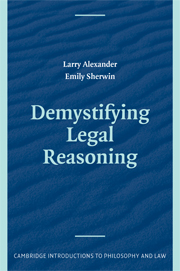Book contents
- Frontmatter
- Contents
- Introduction
- PART ONE Law and Its Function
- PART TWO Common-Law Reasoning: Deciding Cases When Prior Judicial Decisions Determine the Law
- II Ordinary Reason Applied to Law: Natural Reasoning and Deduction from Rules
- III The Mystification of Common-Law Reasoning
- IV Common-Law Practice
- PART THREE Reasoning from Canonical Legal Texts
- Epilogue: All or Nothing
- Selected Bibliography
- Index
- References
III - The Mystification of Common-Law Reasoning
Published online by Cambridge University Press: 05 June 2012
- Frontmatter
- Contents
- Introduction
- PART ONE Law and Its Function
- PART TWO Common-Law Reasoning: Deciding Cases When Prior Judicial Decisions Determine the Law
- II Ordinary Reason Applied to Law: Natural Reasoning and Deduction from Rules
- III The Mystification of Common-Law Reasoning
- IV Common-Law Practice
- PART THREE Reasoning from Canonical Legal Texts
- Epilogue: All or Nothing
- Selected Bibliography
- Index
- References
Summary
We argued in the preceding chapter that there are two and only two plausible models of judicial reasoning: the natural model and the rule model. The natural model incorporates two forms of reasoning: moral reasoning through the method of reflective equilibrium and empirical reasoning. The rule model adds a third form of reasoning, deduction from authoritative rules. These forms of reasoning are not unique to law but are common to all subjects of human deliberation. In our view, they are the only tools judges need to decide cases and the only tools they use in fact.
This is not the prevailing view. Texts on judicial reasoning, as well as judges themselves, often maintain that the primary decision-making method of the common law is reasoning by analogy. Analogical reasoning is the special art of lawyers and judges and the means by which the common law has successfully adapted to changing social conditions. Commentators also maintain that courts reason from legal principles, a method closely linked to the method of analogy.
In this chapter, we intend to demonstrate that judges cannot be doing what they claim. One cannot “reason” by analogy, and legal principles are chimerical. We argue as well that if analogies and legal principles could in fact operate as elements in judicial reasoning, they would tend to lead judges into error, without the compensating benefits of settlement.
- Type
- Chapter
- Information
- Demystifying Legal Reasoning , pp. 64 - 103Publisher: Cambridge University PressPrint publication year: 2008



